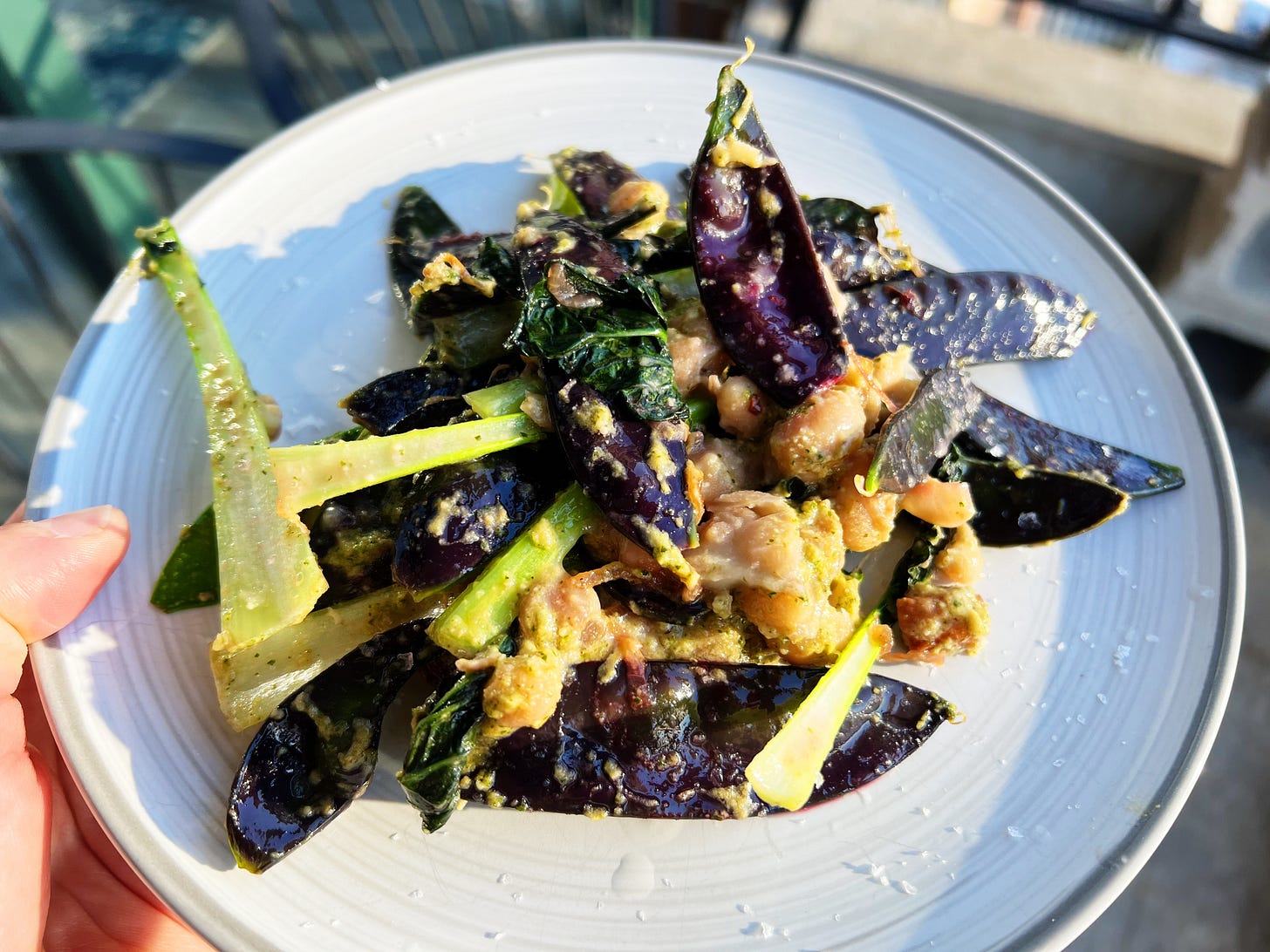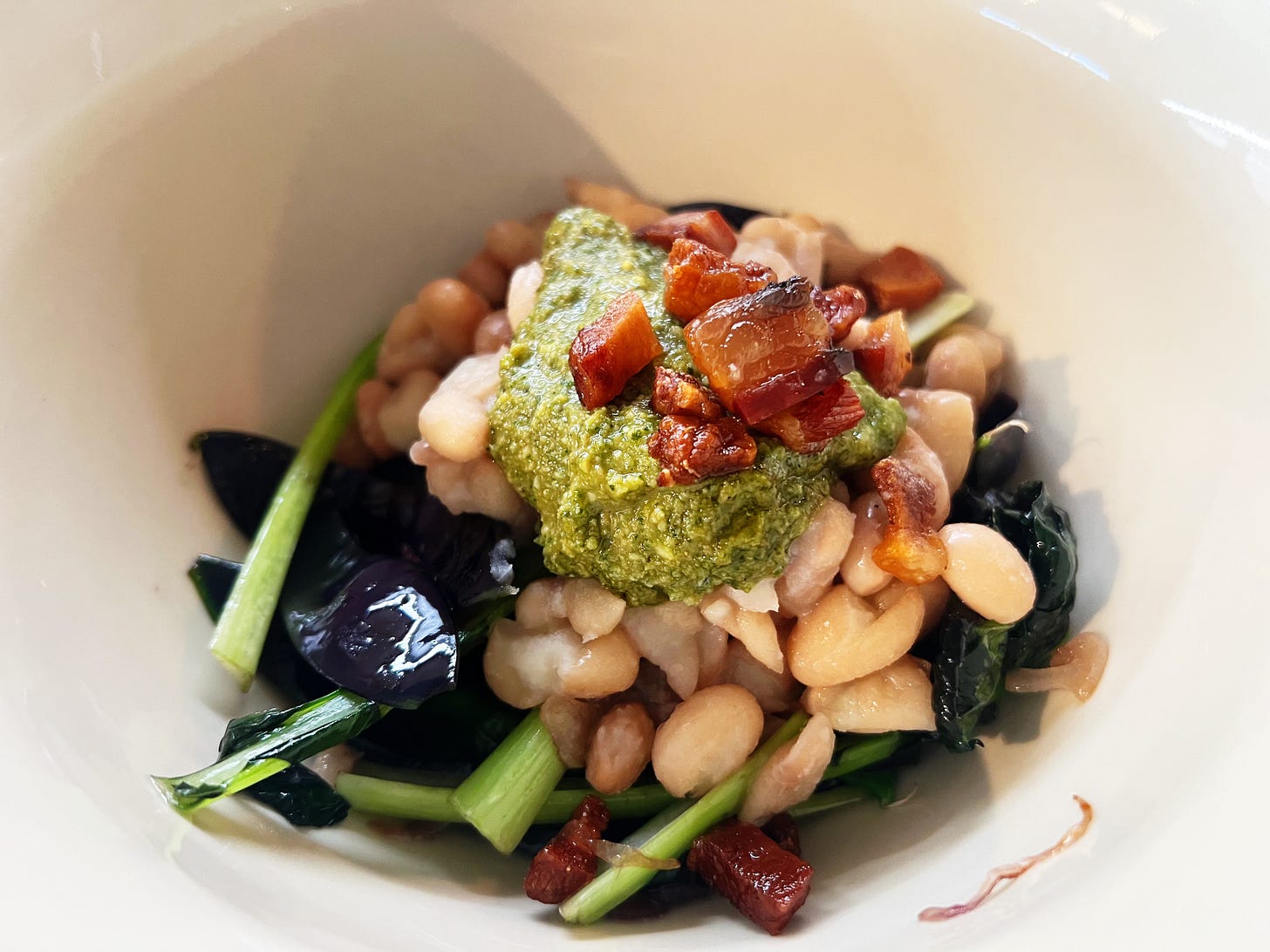The Definition of a Drug, a Case for Nutrient Density Labels, and the Organizations Leading FarmRx
And of course, a recipe: Greens and beans + nuts and herbs (for just 2 bucks) = Goodness
Sometimes I feel like the world we live in today is not so far from the sci-fi scenarios imagined as a kid. Video conferencing. Recreational space travel. Pour a bit of water over a pill and watch it transform into a marshmallow with just the right amount of calories to fuel your day. Start with chemicals and fillers, sprinkle in a few nutrients for good measure, and place inside an eye-popping package absent of any disclaimer that this “food” is indeed poison, and the future is now.
Johann Hari shares a much-needed perspective – arguments in favor of GLP-1 agonists like Ozempic in his new book, The Magic Pill. These therapies can not only save your life but increase life’s quality. Though I can’t shake my fear of the worst-case scenario - what might result if the root cause of metabolic dysfunction is further buried on a mass scale.
No drug on the market can reverse metabolic disease - e.g., Type-2 Diabetes, a downstream effect of metabolic dysfunction the U.S. healthcare system built substantial infrastructure around managing. Before we developed therapies that manage these illnesses in our typical, wack-a-mole-type fashion, physicians prescribed various diets to try to find the cure for Type-2 diabetes.
It took a ton of iteration until researchers learned that consuming fewer carbohydrates and more fat proved effective for patients willing and able to make the shift. But habit change is difficult despite its life-changing effects. When insulin hit the market, frustrated patients and providers looked to medication as the de-facto therapy, and dietary change became mostly disregarded by modern medicine.
If you like what you’re reading, consider upgrading to a paid subscription or sharing The Savory with a friend.
Food or Medicine
Food as Medicine, Food is Medicine, or as Ed Gaskin, Boston Herald reporter so cleverly coined Food “or” Medicine. Food as Medicine (FAM) is the integration of food as a supplement or alternative to our current standard of care. Patients struggling with metabolic dysfunction, typically stemming from a diet rich in ultra-processed foods, can participate in a Food as Medicine program, such as a prescription for fresh produce (ProduceRx).
These programs vary by state and health plan (a.k.a., payers) but generally take the form of Produce Prescriptions, Medically-Tailored Meals, and/or Pantry Stocking, coupled with nutrition and culinary education, and are administered once a physician discovers a patient is food insecure and/or has a chronic disease as part of a Social Determinants of Health (SDOH) screening.
Policy is shifting toward broader FAM coverage at both state and federal levels. For example, Illinois recently integrated and received approval for ProduceRx and other Food as Medicine benefits as part of their state Medicaid program. Moreover, FAM initiatives extend beyond program implementation and delivery (e.g., nutritionist salaries, cost of food) and into the technological infrastructure and payment pathway investment required to facilitate coordination between physicians, insurers, and community-based organizations.
“Poor nutrition is the top cause of death and disability in the United States. I should just drop the mic right there…” - Dr. Dariush Mozaffarian MD, DrPH
Excerpt from the U.S. Senate Testimony on Feeding a Healthier America: Current Efforts and Potential Opportunities for Food is Medicine.

Healthcare spending totaled $4.5 trillion dollars in 2022, accounting for 17.3% of our GDP. Diet-related chronic disease was responsible for 13%, roughly 604 billion, of our national healthcare expenditure.1 This cost does not reflect the loss of economic output that an otherwise healthy individual could contribute or the diminished quality of life that roughly 70% of our population struggles with day-to-day. This is not only unacceptable, it’s unsustainable.
Payers developed FAM programs in response to evidence showing how 40% of an individual’s health depends on societal factors such as income and housing quality. For example, Kaiser Permanente launched a survey back in 2018 asking staff to share what they saw as the origin of our most pressing health issues. Food insecurity (what can cause an individual to substitute whole for ultra-processed foods) was a top concern, so Kaiser began connecting patients to community-based organizations (CBOs) and federal programs like SNAP for food assistance, and was quickly recognized as a FAM Center of Excellence.
Although FAM programs have proven effective at improving health outcomes and lowering total cost of care, payers want to see how “X” health-tech provider and/or community-based organization (CBO) serves their particular patient population.
Roughly 350 individuals from health plans (e.g., Kaiser, Blue Cross Blue Shield North Carolina), CBOs, and health-tech/food delivery entrepreneurs came together to discuss the barriers and opportunities to implementing Food as Medicine programs at a FAM-dedicated Summit.
What are the arguments for deeper Food as Medicine integration within our U.S. healthcare system? What are the lessons learned from successful program implementation and coordination? What barriers still exist?
A summary of key takeaways from the FAM conference will follow in a separate post. To not miss a FAM beat (in addition to some delicious, straightforward, seasonal recipes) hit the “Subscribe” button below!
For now, let’s look at outcomes data from Geisinger’s study referenced time and time again by FAM stakeholders:
Geisinger estimates $16,000 to $24,000 saved for the average 2.0-point reduction in HbA1c seen as a result of their FAM program. Compared to the $3,500 - $4,000 spent on food (let’s call it medication, just for the sake of it), the savings totaled $12,500 - $20,000 per member, per year.
And from Blue Cross Blue Shield of North Carolina’s food delivery and health coaching pilot:
BCBS NC estimates a medical expense reduction anywhere from $8.5 to $13.1 million annually if their 6-month FAM program were extended to all eligible members.
What is a drug?
Aside from the deeply embedded treatment infrastructure, one of the biggest barriers to wider Food as Medicine adoption seems to be our societal view of a “drug” - a chemical or biological substance derived from a lab whose side effects require monitoring long after they’ve been used by populations larger than those studied in clinical trials.
Why does Food as Medicine sound hippy-dippy to so many? Mark Walker, CEO of Performance Kitchen asked this eye-opening question - What is a drug?
The definition of “drug” by Merriam Webster
a. A substance or preparation used in treating disease
b. Something that affects well-being
A payer will place a drug with higher efficacy, reduced risk of side effects, and lower direct and indirect costs on a higher formulary tier (e.g., preferred vs. non-preferred vs. specialty.) Despite mounting evidence, Food as Medicine programs are still niche, interwoven into Social Determinants of Health SDOH, vs. weighted against another “drug” to assess its cost/benefit tradeoffs.
I started The Savory to stir up excitement for the health, connectivity, and joy of sourcing and cooking with food grown by small-scale farmers, but I struggled with the reality that roughly 13% of the U.S. population does not have reliable access to affordable, nutritious foods. I grapple with the stark divide between not only ultra-processed and whole foods, but whole foods brought to you by corporate giants (e.g., that mealy, tasteless, out-of-season tomato) and those grown by farmers engaged in regenerative farming practices conducive to soil health.
Soil health leads to greater nutrient density, and nutrient density leads to greater health. What if there was a nutrient-density label that downstream, paid farmers more for higher-quality produce?


And what if these foods were integrated into FAM?
Henry Crews from the Green Rural Redevelopment Organization shared his experience bridging the gap between locally grown food and individuals facing economic hardship and chronic disease during the Summit.
FreshRx Oklahoma runs a similar program, supporting local farmers with expansion through bulk CSA purchasing and operational support. Erin Martin, Co-founder and Director of FreshRx OK recently testified to Congress, sharing not only improved health and cost savings but the economic ripple effects within the community. Erin’s program received GusNIP funding, which can serve as a gateway for building a program robust enough to attract a payer/health plan for partnership.
Prevention
One point mentioned throughout the conference was how you can’t prove a negative; i.e., how it’s difficult for a payer to capture and communicate value for a pre-diabetic population when those costs haven’t yet been realized.
Why not construct a study segmenting pre-diabetic patients into two groups, following the outcomes of Group 1 receiving the standard of care (that is, do nothing until the patient receives a diabetes diagnosis at which point, they will likely be given insulin and/or a GLP-1) and Group 2 enrolled in a FarmRx FAM program.
If you’re in or interested in the Food as Medicine space, reach out by dropping a note in the comments section below! I would love to turn this post into a conversation.
A lesson from the conference was to never disregard the joy that food brings. One of the best things I ate in the past few weeks was a combination of old and new - choy sum from Tomato Mountain Farm, white beans cooked and saved for this very occasion, a scoop of carrot top pesto, and crispy guanciale.
Enjoy layered or mixed to combine. It’s delicious either way.
*Recipe: Sauteed Choy Sum with Creamy Beans
Note from Chérie: The key is to use any greens that are in season and locally grown. For the pesto, I riffed on this recipe from Epicurious, substituting pine nuts for walnuts because they’re roughly 1/4 of the price.
Cooking time: 5 minutes prep, 8-10 minutes cooking time
serves 2 as an entree
Ingredients:
2 handfuls of choy sum or another leafy green like bok choy,
1 garlic cloves and/or 1 small spring onion, depending on preference and what you have on hand
3/4 cup cooked white beans
1 1/4-inch-thick slabs of guanciale cut into roughly 1/4-inch cubes
1-2 teaspoons of salt
Method:
Wash and lay out choy sum to dry. If the stems are tender, you can leave the leaves intact, otherwise cut or tear the stem from the leaf. (You can tell if the stems are tender by taking a bite and seeing if they’re easy to chew.)
Place diced guanciale in your pan and turn on to low - medium heat. While keeping a close eye on the guanciale, grate, smash, or chop your garlic and/or thinly slice the spring onion bulb. (You can save the green part for roasting or stock.)
Stir the guanciale frequently, flipping it on all sides so the cubes crisp evenly. Once they’ve turned a light-medium brown, remove from the pan and set to the side.
Place your onion and/or garlic in the pan of guanciale fat and sauté for 1-2 minutes. Add a little salt, place in your choy sum (cooking stems for 1-2 minutes first if separated), and sauté for 3-5 minutes, adding a couple of pinches of salt halfway through. Taste throughout to check for doneness and seasoning.
Take greens out of the pan and place onto a large plate to stop the cooking process. Sprinkle a little additional salt over top and a squirt of lemon juice if you have one kicking around. Scoop warmed beans, a generous spoonful of pesto, and a sprinkle of crispy guanciale over top. Enjoy layered or mixed together!
As always, I can’t thank you enough for reading. There’s a lot of work to be done but we’re moving in the right direction.
In good health,
Chérie
THANK YOU FOR READING! THE SAVORY WOULDN’T BE HERE IF IT WEREN’T FOR YOUR SUPPORT ♥️
If you like what you’ve read, consider upgrading to a paid subscription, or even better, share The Savory with anyone and everyone you know!
The Rockefeller Foundation, & Shah, R. J. (2021b). True Cost of Food: Measuring what matters to transform the U.S. food system. https://www.rockefellerfoundation.org/wp-content/uploads/2021/07/True-Cost-of-Food-Full-Report-Final.pdf







great information, Cherie, thank you.